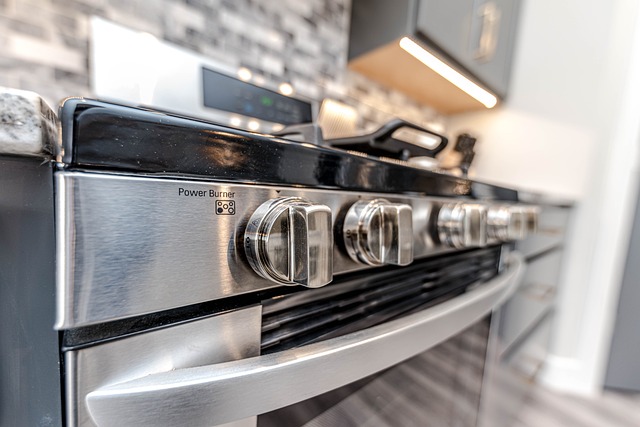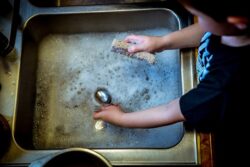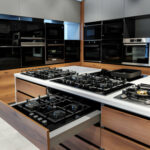
When it comes to the heart of your kitchen, the gas range plays a pivotal role in cooking up delightful meals for you and your family. However, keeping this essential appliance clean and well-maintained is not only crucial for its longevity but also for the safety of your home. In this comprehensive guide, we’ll delve into the nitty-gritty details of how to clean and maintain your gas range, emphasizing safety as the top priority.
See also our post on Restaurant Kitchen Cleaning: Maintaining Hygiene Standards
Getting Started
1. Disconnect the Gas Supply
Before embarking on any cleaning or maintenance tasks, ensure that the gas supply to the range is turned off. Safety first! Locate the gas shut-off valve, typically situated behind the appliance, and gently turn it to the off position. This prevents any accidental gas leaks during the cleaning process.
2. Allow Cooling Time
After cooking, let the gas range cool down before attempting to clean it. Rushing into cleaning while the surfaces are still hot can lead to burns and injuries. Patience is key, so give it ample time to cool to a safe temperature.
3. Gather Essential Supplies
Equip yourself with the necessary cleaning supplies, including mild dish soap, warm water, a soft cloth, and a non-abrasive sponge. Additionally, have a toothbrush or small brush on hand for intricate areas. Avoid harsh chemicals that can damage the finish and compromise safety.
4. Read the Manufacturer’s Instructions
Refer to the gas range’s user manual for specific cleaning and maintenance guidelines provided by the manufacturer. Following these instructions ensures you’re taking the right steps without causing harm to the appliance or voiding the warranty.
5. Dress Appropriately
Wear protective gear such as gloves and aprons to shield yourself from cleaning agents and potential grease splatters. Safety goggles can also be beneficial, especially when dealing with stubborn stains that may require a bit of elbow grease.
Cleaning the Burners and Grates
Remove Burner Caps and Grates
Start by taking off the burner caps and grates from the gas range. Soak them in warm, soapy water to loosen any grime. This step makes it easier to clean the individual components thoroughly.
Scrub with a Non-Abrasive Sponge
Use a non-abrasive sponge to scrub away any residue on the burner caps and grates. Gentle circular motions help remove stubborn stains without scratching the surfaces. Rinse them thoroughly and allow them to air dry before placing them back.
Wipe Down Burner Heads
Wipe the burner heads with a damp cloth, ensuring no soap residue is left behind. Take extra care around the igniter and other sensitive components. A toothbrush can be handy for reaching tight spots and crevices.
Clean Gas Ports
Use a small, soft brush to clean the gas ports on the burner heads. Clearing any debris or buildup in these ports ensures a consistent flame and efficient gas flow during cooking.
Check for Gas Leaks
Inspect the connections between the burners and the gas supply for any signs of leaks. Apply a soapy water solution to the joints and look for bubbles; if present, tighten the connections or seek professional assistance.
See also our post on Zero-Waste Kitchen Cleaning: Sustainable Solutions for Spills and Stains
Oven Cleaning
Remove Oven Racks
Take out the oven racks and set them aside. Soak them in warm, soapy water to break down grease and grime. Meanwhile, this step provides easier access to the oven’s interior.
Wipe Interior Surfaces
With a damp cloth or sponge, wipe down the interior surfaces of the oven. Pay special attention to spills and drips on the bottom. For stubborn stains, create a paste using baking soda and water, apply it, and let it sit before wiping clean.
Clean Oven Door
Don’t forget the oven door! Use a glass cleaner or a mixture of vinegar and water to clean both the interior and exterior of the door. Ensure clear visibility through the glass for safe monitoring of your cooking.
Clean Oven Vents
Inspect and clean the oven vents to ensure proper ventilation during cooking. A vacuum or a soft brush can be useful to remove any accumulated dust or debris.
Check Oven Seal
Examine the oven seal for any signs of wear or damage. A proper seal is crucial for energy efficiency and preventing heat from escaping. Replace the seal if necessary.
Control Panel and Knobs
Remove Knobs
Take off the control knobs from the gas range. Soak them in warm, soapy water to remove grease and grime. Cleaning the knobs separately ensures a thorough job.
Wipe Control Panel
Gently wipe the control panel with a damp cloth. Avoid using excess water around control knobs to prevent any electrical damage. Dry the area thoroughly to prevent corrosion.
Clean Knob Openings
Use a toothbrush or a cotton swab to clean the openings where the control knobs attach. This helps prevent any obstruction that could affect the ease of use.
Inspect Wiring
While the knobs are off, visually inspect the wiring behind the control panel. If you notice any frayed wires or loose connections, it’s essential to address them promptly to ensure safe operation.
Replace Knobs
Once the knobs are clean and dry, securely place them back on the control panel. Ensure they fit snugly and turn smoothly for accurate temperature adjustments.
See also our post on The Art of Eco-Friendly Dishwashing: Green Practices in the Kitchen
Exterior Maintenance
Use a Mild Cleaner
For the external surfaces of the gas range, a mild cleaner is your best friend. Opt for a mixture of dish soap and warm water to wipe down the surfaces. Harsh chemicals can damage the finish, compromising both aesthetics and safety.
Clean Control Knobs
Wipe the control knobs with the same mild cleaner used for the exterior. Ensure that no residue or grease is left behind, maintaining a clean and functional appearance.
Polish Stainless Steel
If your gas range has stainless steel elements, use a specialized stainless steel cleaner or a mixture of vinegar and olive oil to restore its shine. Buff the surfaces with a soft cloth for a polished finish.
Check for Gas Odors
While cleaning the exterior, be vigilant for any unusual odors. If you detect a gas smell, turn off the supply immediately, ventilate the area, and seek professional assistance to address potential gas leaks.
Secure Gas Line
Inspect the gas line connection to the range for any signs of wear or damage. A secure connection is crucial for safety, preventing gas leaks that could lead to hazardous situations.
Routine Maintenance Tips
Regular Inspection
Periodically inspect the gas range for signs of wear, damage, or malfunction. Promptly address any issues to prevent safety hazards and extend the lifespan of the appliance.
Clean Drip Pans
If your gas range has drip pans, remove and clean them regularly. This prevents the buildup of grease and food particles, reducing the risk of flare-ups and maintaining a clean cooking environment.
Monitor Flames
During operation, observe the flames on the burners. They should burn consistently blue. If you notice any irregularities, such as yellow flames, it could indicate an issue with the gas-air mixture, requiring professional attention.
Keep Surrounding Areas Clear
Ensure that the area around the gas range is clear of combustible materials, such as paper towels or dishcloths. This minimizes the risk of accidental fires during cooking.
Schedule Professional Maintenance
Consider scheduling professional maintenance at least once a year. Certified technicians can conduct a thorough inspection, address potential issues, and ensure the gas range operates safely and efficiently.
Gas Range Safety Tips
Install a Carbon Monoxide Detector
As an extra layer of safety, install a carbon monoxide detector in the kitchen. This device alerts you to any potential gas leaks or carbon monoxide buildup, providing early warnings for a safer environment.
Teach Family Members
Educate everyone in your household, including children, about the importance of gas range safety. Emphasize the significance of proper usage, cleaning, and the immediate response to any unusual smells or sounds.
Ventilate the Kitchen
Ensure proper ventilation in your kitchen by using exhaust fans or opening windows when cooking. Adequate ventilation helps dissipate any gas or fumes, maintaining a safe and comfortable cooking space.
Store Flammable Items Safely
Keep flammable items, such as paper towels and cooking oils, away from the gas range. Store them in designated areas to prevent accidental fires and maintain a clutter-free cooking environment.
Emergency Response Plan
Establish an emergency response plan for gas-related incidents. Know how to shut off the gas supply, evacuate the area, and contact emergency services if needed. Being prepared ensures a quick and effective response to unforeseen situations.
See also our post on How to Prevent Cross-Contamination in Office Spaces
Conclusion
In wrapping up our guide on “How to Clean and Maintain Your Gas Range: Safety First,” let’s sum it all up. Taking care of your kitchen buddy, the gas stove, isn’t just about making it look shiny. It’s also about making sure it’s safe for cooking up your favorite meals.
We’ve learned that before diving into any cleaning adventure, it’s crucial to turn off the gas supply. Safety comes first! Letting the stove cool down after cooking is like letting it take a nap – it needs it. And, of course, wearing gloves and an apron is like giving yourself a little kitchen superhero outfit – protecting you from cleaning battles.
Cleaning burners, grates, and even the oven involves a bit of soaking and scrubbing. It’s like giving your stove a spa day, but for appliances. Checking for gas leaks is a must – just a bit of soapy water helps spot them. And remember those oven racks? They deserve a bath too.
The control panel and knobs, the external surfaces, and even the wiring behind the scenes need a bit of attention. It’s like saying, “Hey, I see you working hard, let me help you out.” And regular check-ups, like inspecting for wear and tear, cleaning drip pans, and keeping the kitchen clutter-free, are like taking your gas range to the doctor for a yearly check-up.
But, above all, we’ve made sure that safety is the superhero cape of our gas range. Installing a carbon monoxide detector, teaching everyone at home about gas safety, and having an emergency plan in place are like having the best guardians watching over your kitchen adventures.
So, as you say goodbye to this guide, remember, keeping your gas range clean isn’t just about looks; it’s about creating a safe space for all your cooking dreams. Let your gas range shine, and may every meal you cook be a safe and happy one!







